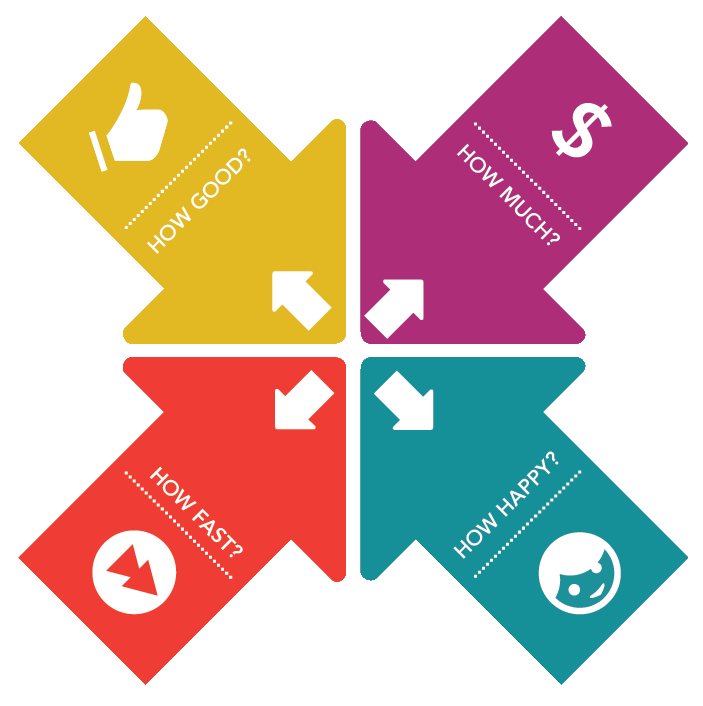Agile Metrics are very important part of an agile software development process. These metrics help software teams to supervise productivity in workflow stages, check, and control software quality. It brings clarity to the development process.
An agile theory is to deliver a fully functional product. Therefore, we need to measure aspects relating to the product quality and timely delivery. Agile Metrics confirms whether you are drawing benefits from the current development process. Are you able to meet the dead lines and maintain the budgets? The development teams and management can measure development quality, the overall productivity, and accurately predict the influence on customers.
- Lean metrics: This ensures the purposeful activities that create value for customers and business organizations by elimination of improvident activities. It commonly includes the metrics for lead-time and cycle-time.
- Kanban metrics: It allows us to focus on workflow, properly organize, and prioritize work to get it done. Generally, used metric is a cumulative flow.
- Scrum metrics: We can predict the deliverables in terms of working software to the customers. One of the common metrics is the team velocity and the burndown chart.
We need Agile Metrics to match the ever-changing requirements of customers. Along with the product development, a simultaneous study using Agile Metrics is helpful. It enables to plan before hand and deliver quality software before time.
Scrum Metrics:
This agile methodology is for managing development projects. The estimation of work and smaller sprints of few weeks enables faster delivery of tested features. Sprint planning allows detailing of tasks for particular feature. We can check to what level completion is possible on weekly basis. Discussions scheduled on daily basis helps the developers to share the obstacles. You can find solutions for the identified issues at early stage. At the end of each sprint, the contributors have gained new insights; they can share to improve the development process.
Agile Metrics effectiveness depends on the planning. It considers sprint frequency, estimated cycle time to implement the idea and release dates. The commitment to deliver the best software with zero defects is no more a dream. Make it possible with powerful agile environment and innovative vision.
Accurate results and precise interpretations are possible when the teams use agile metrics. Define metrics from initialization, blockades, and in relation with the development process. You can have combinations with other metrics. Selecting agile metrics should not be due to its simplicity or complexity. Decision can be on the targets we have defined and the insights we receive. We can measure absolutely anything but need to make up your mind on what is useful. Focus on improving the quality of development, service, and customer satisfaction.
One way of looking at agile metrics is what your goals are. Are there any probable obstacles to achieve them in definite period?
Benefits of Agile Metrics to the business:
- Frequent delivery of software
- Continuous observation and improvement
- Team work of development team and management team
- Measurable actions and insights
- Appropriate process to release pressure and fine-tune development
- Meeting customer and stake holder’s expectations
- Motivational factor for work atmosphere
- Define milestones and remove lags
- Maintain pace, security and readability
- Create sustainable software with technical excellence
Powerful Agile Metrics for improved release, pre-release and post-release activities:
Sprint Burndown: Focus on how much work is remaining in the sprint. This chart can visualize number of story points completed during the sprint and those remaining. It helps to forecast whether the scope of sprint scope is achievable or requires re-scheduling. It immediate actionable items it gives with clear status of what the sprint has delivered so far. Reliability it brings in development is exceptional with the representation of hours remaining to achieve in particular sprint. It helps in dealing with newly added requirements even after the project definition. This agile metrics can ensure that the productivity of your team remains high.
- Agile Team Velocity: Velocity measures story points completed by a team on an average in past few sprints. Estimating time required to accomplish the remaining in upcoming sprints is simpler. This result metric calculates the value delivered to the customers in cycle of sprints. Comparison across teams is not what you can expect from velocity as the story points and its definition is different.
- Escaped Defects and Defect Density: We can track defects during iteration and production. This metric is crucial, as it shows number of bugs experienced by users in productions. The escaped defects should be ideally zero as it shows quality of software. Defect density measures the number of defects against the software size, say length of code. The scrum teams need to implement quality agile practices such as test driven development. Continuous integration can add to effectiveness of teams and help deliver faster to meet the market demands. Agile techniques in combination with scrum framework can minimize the defects. We can track the defects and refine the process to prevent the recurring issues and improve the project processes.
- Lead Time: It lets you measure the total time taken from story enters the system until the sprint is completed, or released to the customers. Lead time enables you trace the value of your software for the business. The reduced lead-time suggests efficient development in project.
- Code Coverage: This metric measures code coverage that shows the percentage of your code tested. Code coverage is measured using number of methods like statements, branches, or conditions executed in test suite. It projects basic picture of how much codebase has been tested. A low code coverage points towards low code quality but at the same time the high code, coverage does not indicate high quality. You can even run code coverage automatically as integral part of every build. The relation of coding with the UI or integration are not counted thus it presents crude visualisation. Code coverage provides concrete view on progress of your project.
- Failed Deployments: This metric measures the number of deployments in test and production environments. The reliability of environment helps to judge the quality of software created by the teams. Clarity it brings by indicating that the release is ready for production can save from failure in deployments.
- Time to Market: The time taken by projects to start providing value to the customers and generate revenues for business is time to market. Its calculation is on basis of length and number of sprints before release to production. Value for business is relative term as the ability to use a product is dependent on various factors. Hence, the measuring strategy should change accordingly.The time to market is the number of days from start of development until release. It is irrespective of feature release at the end of every sprint or after multiple sprints. Even the delay in internal processes or testing is part of the time of release. This metric helps companies to be familiar with the ongoing value of scrum projects. Budgeting for projects also considers time to market.
- ROI: Return on Investment from a scrum project calculates total revenue generated from a product as compared to the cost of sprints required for development. We can generate ROI faster by adopting Scrum instead of the traditional development methods. Every sprint creates more features and they reach the customers early. Faster release thus translates in revenue growth. It inverses the costs of projects and enables immediate income generation as soon as the sprint ends.
- Capital Redeployment: It measures if it is beneficial to continue a scrum project. It indicates whether you are drawing value out of it. You can decide if the redeployment of teams can make projects profitable. Capital redeployment confirmation depends on the actual cost, project backlog, number of sprints required to complete the tasks, and available alternative projects. Determining the cost of development can increase the ability to generate revenue. Budgets and opportunities are limited thus; allocation of funds and moving them to different projects can be beneficial.
- Satisfaction surveys: Scrum team’s highest priority is to satisfy the users of their products. The satisfaction of teams can boost morale, create good work environment, and launch surveys. Survey can have different perspectives like the happiness of employee to work with project type and people leading those projects. Surveys can bring enthusiasm in the team and make them share their thoughts through specific questions, which they would have not shared in face-to-face discussions. Scrum team turnover if low suggests healthy team environment. While high scrum team turnover countenance in companies is due to many factors. It can be inefficiencies of development teams, product owners, and their inability to remove the hindrances within projects.A customer satisfaction survey shows the satisfaction level, customer experience with the project as well as the scrum team. One of the well-known metrics used to measure customer satisfaction is the Net Promoter Score.Release Net Promoter Score is ultimate test of agile development, to find whether it is providing value to customers. After release of new software, will the users recommend it to others? It is an important measure of customer satisfaction as it indicates successful software made by the development team.
Involving the teams in using this metrics can change the ROI ratios. They get to know how it is for betterment of teams and organizations. When the scrum team knows about advantages of metrics implementation, the members are likely to follow the process. They can take help of those metrics in product and process improvement.
The Missing Scrum Metrics are the ones that we are able to identify with experience. Mainly the quality issues found after software release in production. Metrics cannot address all quality issues. You can try other automated processes like static code analysis that provides insights into code quality. It can auto clean and correct minor level errors of coding.
The missing data that you find manually without help of agile metrics can also help in testing the product. You may want to figure out minimum resources to make the project work or the ratio between the managers and contributors on a project.
Finding right balance can reduce dependencies of teams.
Dependencies of teams in Agile:
Inter-team dependencies will be different in each project but it can be limited by taking appropriate actions. Depending what you want to achieve, these dependencies can reduce by restructuring products, changing architecture or adapting newer technologies.
Even teams built to handle the project cannot be just the frontend and backend teams. Identify resources for planning, budgeting, visualization, of release. The preplanning sessions are needed for each sprint and synchronize the inter-team dependencies. Companies can build the agile teams and assign roles to them.
Skill versatility of the strong scrum teams increases the ability to produce high quality software at higher pace. If the individual skills and level are tracked, and matched with the organization’s skill level and gauge the growth.
Project attrition rate is not same as capital redeployment. Thus, the project’s that have pre-closures or extend beyond expectation requires scrutiny. Project attrition reasons are lack of proper planning, unorganized priorities, unaddressed impediments, or operational issues.
Conclusion:
Being on right track and continuous improvement can satisfy the contributing teams and stakeholders. Agile metrics thus converts to reliable software developed by organizations. The business value it carries supports the team, leaders, and owners to maintain transparency.
Agile Metrics is an ongoing help that is available to throw light on each stage of production. Charting and escalating remaining work to finish the release cycle or what value adding did the program do. Just as it shows the estimation accuracy, it also shows the team’s efficiency to deal with complexities and the growth during the process.





